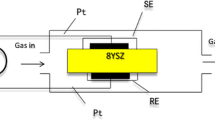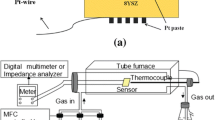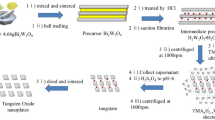Abstract
In this paper, yttria-stabilized zirconia (YSZ) electrochemical sensors equipped with a perovskite-type oxide (either LaFeO3 or LaCrO3) sensing electrode (SE) were fabricated and examined in terms of their NO2 sensing properties at high temperatures. A linear correlation was obtained for these devices between the electromotive force (EMF), and the logarithm of the NO2 concentration from 30 to 500 ppm in the temperature range 500–600 °C. The LaFeO3 device proved more sensitive for all temperatures. The variation of the EMF as a function of the O2 concentration at a given NO2 concentration revealed that LaFeO3 has a better catalytic activity to O2 than LaCrO3, leading to larger EMFs.






Similar content being viewed by others
References
Azad AM, Akbar SA, Mhaisalkar SG, Birkefeld LD, Goto KS (1992) Solid-state gas sensors: a review. J Electrochem Soc 139:3690–3704
Brosha EL, Mukundan R, Brown DR, Garzon FH, Visser JH (2002) Development of ceramic mixed potential sensors for automotive applications. Solid State Ionics 148:61–69
Brosha EL, Mukundan R, Brown DR, Garzon FH (2002) Mixed potential sensors using lanthanum manganate and terbium yttrium zirconium oxide electrodes. Sensors Actuators B Chem 87:47–57
Yoo J, Van Assche FM, Wachsman ED (2006) Temperature-programmed reaction and desorption of the sensor elements of a WO3/YSZ/Pt potentiometric sensor. J Electrochem Soc 153:H115–H121
Yoo J, Chatterjee S, Wachsman ED (2007) Sensing properties and selectivities of a WO3/YSZ/Pt potentiometric NOX sensor. Sensors Actuators B Chem 122:644–652
Lu G, Miura N, Yamazoe N (2000) Stabilized zirconia-based sensors using WO3 electrode for detection of NO or NO2. Sensors Actuators B 65:125–127
Miura N, Nakatou M, Zhuiykov S (2004) Development of NOX sensing devices based on YSZ and oxide electrode aiming for monitoring car exhausts. Ceram Int 30:1135–1139
Yan Y, Miura N, Yamazoe (1994) Potentiometric sensor using stabilized zirconia and tungsten oxide hydrogen sulfide. Chem Lett 1733–1736
Miura N, Wang J, Nakatou M, Elumalai P, Zhuiykov S, Hasei A (2006) High-temperature operating characteristics of mixed-potential-type NO2 sensor based on stabilized-zirconia tube and NiO sensing electrode. Sensors Actuators B 114:903–909
Parka J, Yoon BY, Park CO, Lee W, Lee CB (2009) Sensing behavior and mechanism of mixed potential NOX sensors using NiO, NiO (+YSZ) and CuO oxide electrodes. Sens Actuators B 135:516–523
Yoon JW, Grilli ML, Bartolomeo ED, Polini R, Traversa E (2001) The NO2 response of solid electrolyte sensors made using nano-sized LaFeO3 electrodes. Sens Actuators B 76:483–488
Geyu L, Diao Q, Yin C, Yang S, Guan Y, Cheng X, Liang X (2014) High performance mixed-potential type NOX sensor based on stabilized zirconia and oxide electrode. Solid State Ionics 262:292–297
Diao Q, Yin C, Guan Y, Liang X, Wang S, Liu Y, Yunfeng H, Chen H, Geyu L (2013) The effects of sintering temperature of MnCr2O4 nanocomposite on the NO2, sensing property for YSZ-based potentiometric sensor. Sensors Actuators B Chem 177:397–403
Hibino T, Kuwahara Y, Otsuka T, Ishida N, Oshima T (1998) NOX detection using the electrolysis of water vapor in a YSZ cell Part I. NOX detection. Solid State Ionics 107:213–216
Plashnitsa VV, Ueda T, Elumalai P, Miura N (2008) NO2 sensing performances of planar sensor using stabilized zirconia and thin-NiO sensing electrode. Sensors Actuators B 130:231–239
Miura N, Wang J, Nakatou M, Elumalai P, Hasei M (2005) NOX sensing characteristics of mixed potential-type zirconia sensor using NiO sensing electrode at high temperatures. Electrochem Solid-State Lett 8:H9–H11
Mondal SP, Dutta PK, Hunter GW, Ward BJ, Laskowski D, Dweik RA (2011) Sensors Actuators B Chem 158(1):292–298
Miura N, Zhuiykov S, Ono T, Hasei M, Yamazoe N (2002) Mixed potential type sensor using stabilized zirconia and ZnFe2O4 sensing electrode for NOX detection at high temperature. Sens Actuators B 83:222–229
Zhuiykov S, Ono T, Yamazoe N, Miura N (2002) High-temperature NOX sensors using zirconia solid electrolyte and zinc-family oxide sensing electrode. Solid State Ionics 152–153:801–807
Miura N, Lu G, Yamazoe N (1998) High-temperature potentiometric/amperometric NOX sensors combining stabilized zirconia with mixed-metal oxide electrode. Sens Actuators B 52:169–178
Macama ER, Blackburn BM, Wachsman ED (2011) Effect of La2CuO4 electrode area on potentiometric NOX sensor response and its implications on sensing mechanism. Sensors Actuators B 158:304–312
Macama ER, Blackburn BM, Wachsman ED (2011) The effect of La2CuO4 sensing electrode thickness on a potentiometric NOX sensor response. Sensors Actuators B 157:353–360
Chen Y, Xiao J (2014) Effects of YSZ addition on the response of La2CuO4 sensing electrode for a potentiometric NOX sensor. Sensors Actuators B 192:730–736
White B, Chatterjee S, Macam E, Wachsman E (2008) Effect of electrode microstructure on the sensitivity and response time of potentiometric NOX sensors. J Am Ceram Soc 91:2024–2203
Park CO, Miura N (2006) Absolute potential analysis of the mixed potential occurring at the oxide/YSZ electrode at high temperature in NOx-containing air. Sensors Actuators B 113:316–319
Miura N, Lu G, Yamazoe N, Kurosawa H, Hasei M (1996) Mixed potential type NOx sensor based on stabilized zirconia and oxide electrode. J Electrochem Soc 143:L33–L35
Miura N, Kurosawa H, Hasei M, Lu G, Yamazoe N (1996) Stabilized zirconia-based sensor using oxide electrode for detection of NOx in high-temperature combustion-exhausts. Solid State Ionics 86–88:1069–1073
Author information
Authors and Affiliations
Corresponding author
Rights and permissions
About this article
Cite this article
Sun, X., Zhang, C., Feng, T. et al. Sensing behavior of mixed potential NO2 sensors equipped with LaMO3 (M = Fe or Cr) sensing electrodes. Ionics 21, 1725–1730 (2015). https://doi.org/10.1007/s11581-014-1338-2
Received:
Revised:
Accepted:
Published:
Issue Date:
DOI: https://doi.org/10.1007/s11581-014-1338-2




